Hosted by
Paper in Architecture: Research by design, engineering and prototyping
Synopsis
Paper is a fascinating material that we encounter every day in different variants: tissues, paper towels, packaging material, wall paper or even fillers of doors. Despite radical changes in production technology, the material, which has been known to mankind for almost two thousand years, still has a natural composition, being made up of fibres of plant origin (particularly wood fibres). Thanks to its unique properties, relatively high compression strength and bending stiffness, low production costs and ease of recycling, paper is becoming more and more popular in many types of industry.
Mass-produced paper products such as special paper, paperboard, corrugated cardboard, honeycomb panels, tubes and L- and U-shapes are suitable for use as a building material in the broad sense of these words — i.e., in design and architecture. Objects for everyday use, furniture, interior design elements and partitions are just a few examples of things in which paper can be employed. Temporary events such as festivals, exhibitions or sporting events like the Olympics require structures that only need to last for a limited period of time. When they are demolished after a few days or months, their leftovers can have a significant impact on the local environment.
In the context of growing awareness of environmental threats and the efforts undertaken by local and international organisations and governments to counter these threats, the use of natural materials that can be recycled after their lifespan is becoming increasingly widespread.
Paper and its derivatives fascinate designers and architects, who are always looking for new challenges and trying to meet the market’s demands for innovative and proecological solutions. Being a low-cost and readily available material, paper is suited to the production of emergency shelters for victims of natural and man-made disasters, as well as homeless persons.
In order to gain a better understanding of paper’s potential in terms of architecture, its material properties were researched on a micro, meso and macro level. This research of the possible applications of paper in architecture was informed by two main research questions:
What is paper and to what extent can it be used in architecture?
What is the most suitable way to use paper in emergency architecture?
To answer the first research question, fundamental and material research on paper and paper products had to be conducted. The composition of the material, production methods and properties of paper were researched. Then paper products with the potential to be used in architecture were examined. The history of the development of paper and its influence on civilisation helped the author gain a better understanding of the nature of this material, which we encounter in our lives every day. Research on objects for everyday use, furniture, pavilions and architecture realised in the last 150 years allowed the author to distinguish various types of paper design and paper architecture. Analysis of realised buildings in which paper products were used as structural elements and parts of the building envelope resulted in a wide array of possible solutions. Structural systems, types of connections between the various elements, impregnation methods and the functionalities and lifespan of different types of buildings were systematised. The knowledge thus collected allowed the author to conduct a further exploration of paper architecture in the form of designs and prototypes.
To answer the second research question, the analysed case studies were translated into designs and prototypes of emergency shelters.
During the research-by-design, engineering and prototyping phases, more than a dozen prototypes were built. The prototypes differed in terms of structural systems, used materials, connections between structural elements, impregnation methods, functionality and types of building. The three versions of the Transportable Emergency Cardboard House project presented in the final chapter form the author’s final answer to the second research question.
Paper will never replace traditional building materials such as timber, concrete, steel, glass or plastic. It can, however, complement them to a significant degree.

